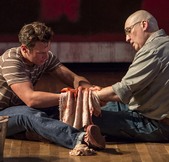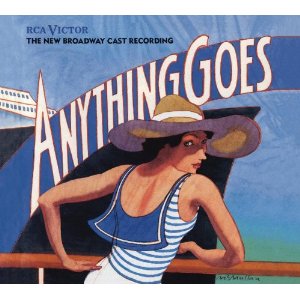SITE GUIDE
SEARCH
REVIEWS
REVIEW ARCHIVES
ADVERTISING AT CURTAINUP
FEATURES
NEWS
Etcetera and
Short Term Listings
LISTINGS
Broadway
Off-Broadway
NYC Restaurants
BOOKS and CDs
OTHER PLACES
Berkshires
London
California
New Jersey
Philadelphia
Elsewhere
QUOTES
TKTS
PLAYWRIGHTS' ALBUMS
LETTERS TO EDITOR
FILM
LINKS
MISCELLANEOUS
Free Updates
Masthead
A CurtainUp Los Angeles Review
Red
By Jon Magaril
|
"Artists should starve. Except me."— Mark Rothko to Ken
|

. Jonathan Groff, Alfred Molina
Photo:Craig Schwartz |
The invited dress in New York, where I sat surrounded by the stars of other shows on Broadway, was an electrifying afternoon. So I arrived at the Taper on a regular Tuesday night confident I'd have a good time, but wondering if the bloom might be off the rose. Nothing doing. The production's better than before.
As before, the production begins half an hour before curtain time. Audience members enter the auditorium to find noted artist Mark Rothko (Alfred Molina) seated and gazing intently at his newest creation, one of his tall, abstract “multiform” paintings in red.
The house lights are up, so people still talk amongst themselves. But quietly. We grow aware of the pulsating push and pull between the brooding man and the painting, us and the painting, and the different tones of red in the painting itself.
When Rothko gets up. the house lights go out. He approaches the canvas, puts his hand on the fuzzy rectangle, leans in as if it were a doorway. Then a stalwart young man enters and the play proper begins.
Red is a two-hander. Ken, a younger man, arrives for his first day of work as Rothko's assistant. By the end of the play, which takes place two years later, he will have grown from dutiful acolyte to defiant challenger. His transformation is charted through impassioned intellectual discussions, in which opinions become grist for personal attacks and revelations.
The talk is never cavalier or merely abstract. Rothko uses it to spur his creativity. He's accepted a high-paying, but troubling, commission to create a series of murals for the Four Seasons restaurant in the new Seagrams Building. Playwright John Logan, whose screenplays for such epic films as Gladiator and The Aviator have earned him three Academy Award nominations, knows first-hand the battles between art and commerce.
Logan takes advantage of his time-off from the flickers to write streams of verbal arias that would never grace the screen at even a third their length. Happily, the talk comes with vivid stage pictures. Both he and his equally celebrated director Michael Grandage follow the lesson Rothko says he's learned from Picasso: “movement is everything.”
Red is at its best when functioning as a four hander. The characters are most compelling when they dirty their mitts making oil paint from pigment powder and oil, pouring the paint, and, in a transfixing pas de deux, priming a canvas with an undercoat of deep dark red. Molina delightfully illustrates a point by tossing a jot of paint powder in the air, creating a magenta punctuation mark to hover over his head.
Many of Molina's moments linger. He's that rare actor equally believable as a man of thought, of feeling, of action. He honors Rothko's intellectual beliefs and artistic ambitions without a moment of grandstanding. He heeds the role's tyrannical monomania while somehow, as an actor, generously giving focus to Jonathan Groff's Ken.
Logan, as he does so skillfully in studio films, gives us types — the tormented artist and the tyro — and fills them in with compelling contradictions. He comes at his two characters from opposite ends. He's drafted Rothko from volumes of academic research. He's built up the fictional Ken from nothing and uses him as our way in, a wide-eyed newbie.
Groff makes an easy figure of identification. Handsome in a hearty, milk-fed way, he's a bit of a blank canvas. His predecessor in the role, Eddie Redmayne in a Tony-winning turn, effortlessly fit the image of the new generation of artist — the downtown bohemians aching to push Rothko's generation aside. Fine-boned, with a more tremulous intensity, his was a more romantic vision of the artist as a young man. But he gave us such easy access to a rich inner life, he threatened to throw the balance off.
Groff skillfully plays to a different archetype. In their first meeting, Rothko remonstrates Ken for not having read the classics, which the Talmudic scholar believes are necessary to build an artistic sensibility. Ken has read only Hamlet. Groff gives us a Hamlet finding the guts to kill the king — figuratively. This makes Ken's violent back story, which is the most contrived bit of writing, work better than before.
We realize we're witnessing not just the passing of the artistic guard but something more basic. As Rothko instructs Ken, (Logan offers plenty of meta-material as a guide to reading his play) : “The child must banish the father. Respect him but kill him.”
Ken starts to push little pins into Rothko's hot air justifications for taking the commission. He asks, “Do you ever wonder if it's the right place for them? . . . It's a restaurant.” Rothko assures Ken, and tries to convince himself, “I will make it a temple.”
In New York, Red played at the Golden, a small proscenium house where Rothko's studio felt cramped. The Taper proves to be the right place for the show. Its thrust stage and raised “stadium” seating evokes ancient Greek theatres. The masterful designer Christopher Oram altered the Broadway design so there's now a NY warehouse-style ceiling atop the playing space. The light fixtures adorning the walls and ceiling now also hang above the audience. We are included.
The average seat is not only at eye level with the actors but, more importantly, on par with the center of the tall paintings which hang, on by one, upstage center. Like never before, they pulsate, soaking up our energy as the focus of the large semi-circular room.
Aided by Adam Cork's numinous original music, the actors' disciplined passion, and the rituals imbedded in the staging, Rothko finally gets his temple. Red rightly makes the work of creativity funny, insightful, and ultimately mysterious. It is a state-of-the art theatre experience, devoutly to be wished.
To read Curtainup's review of the Broadway production go here
|
Red by John Logan Directed by Michael Grandage Cast: Jonathan Groff as Ken, Alfred Molina as Mark Rothko Scenic and Costume Design by Christopher Oram Lighting Design by Neil Austin Composer and Sound Design – Adam Cork Running Time: Ninety-five minutes without intermission Through September 9, 2012 at Mark Taper Forum, 195 N Grand Ave., Downtown Los Angeles (213) 628-2772 www.CenterTheatreGroup.org Reviewed by Jon Magaril |
|
REVIEW FEEDBACK Highlight one of the responses below and click "copy" or"CTRL+C"
Paste the highlighted text into the subject line (CTRL+ V): Feel free to add detailed comments in the body of the email. . .also the names and emails of any friends to whom you'd like us to forward a copy of this review. Visit Curtainup's Blog Annex For a feed to reviews and features as they are posted add http://curtainupnewlinks.blogspot.com to your reader Curtainup at Facebook . . . Curtainup at Twitter Subscribe to our FREE email updates: E-mail: esommer@curtainup.comesommer@curtainup.com put SUBSCRIBE CURTAINUP EMAIL UPDATE in the subject line and your full name and email address in the body of the message. If you can spare a minute, tell us how you came to CurtainUp and from what part of the country. |


 Anything Goes Cast Recording
Anything Goes Cast Recording Book of Mormon -CD
Book of Mormon -CD